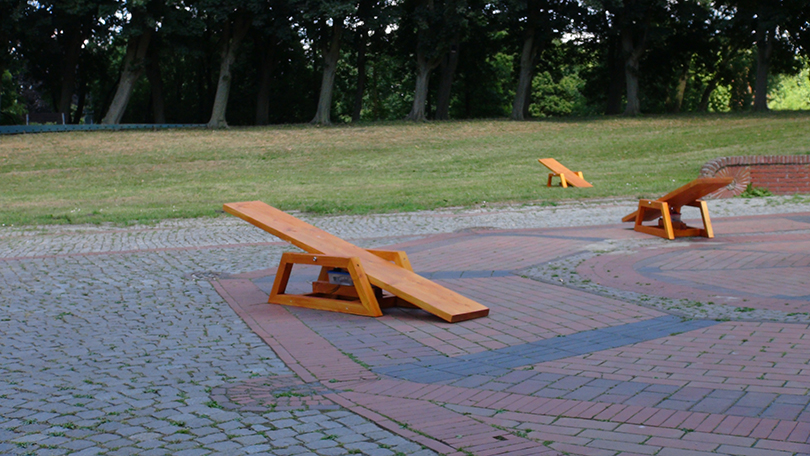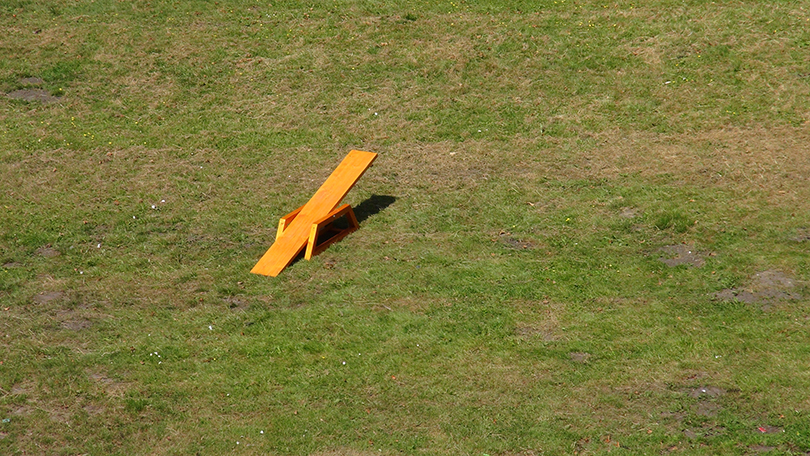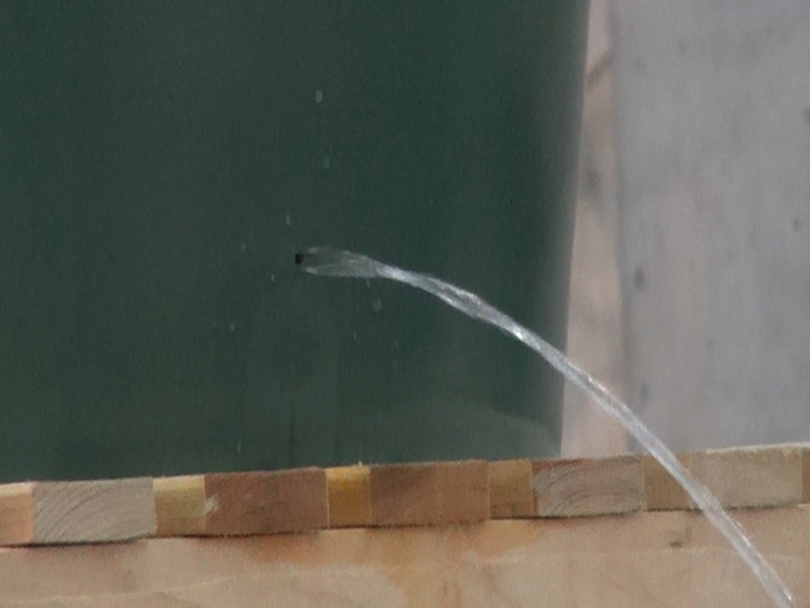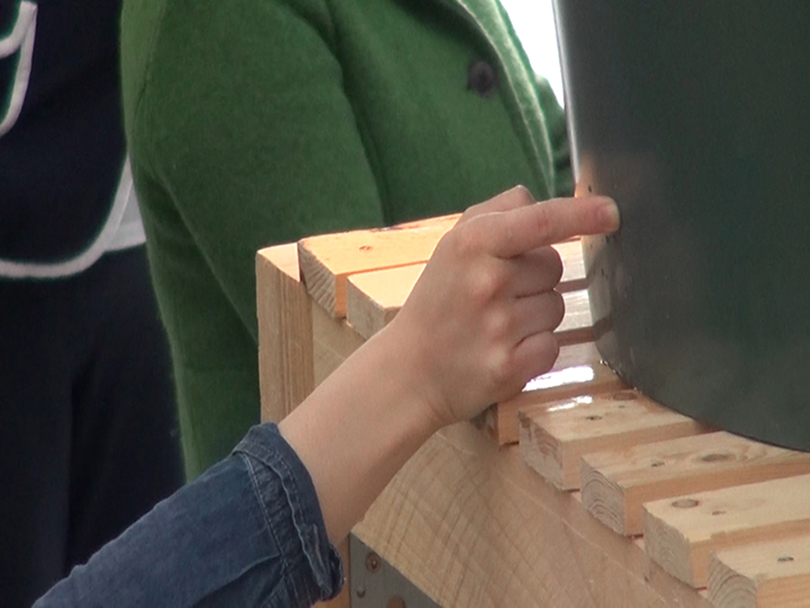


〈Soundseesaw〉, 2018, Interactive installation, wooden seesaw, microcontroller, 200x30x50cm. courtesy of the artist.
Mijin Hyun’s Klangwippe (2018) consists of a few seesaws placed in an open space. Made of wood, a commonplace material, and placed on a grassplot, the seesaws blend in so well with the surrounding landscape that many may not perceive them as an artwork at first glance. Only those who discover and are intrigued by the seesaws will approach them and realize that their shape is out of the ordinary. While most seesaws have handles on both ends, Hyun’s seesaws are just flat wooden boards. Users can operate them in their own ways, and by doing so come to learn a single rule—that the seesaw makes a certain sound when the wooden board reaches a state of equilibrium. The sounds of the seesaws, similar to that of waves or whispering, combine when people move them, trying to find a balance. Unlike ordinary seesaws, which perform an alternating up-and-down movement as the weight on either end fluctuates, Hyun’s seesaws respond to horizontal conditions: another point of balance made imaginable by the object.
In order to generate physical movement from spectators, the artist utilizes video, sound, and motion sensors. What is most interesting about this work is that the movements take on the characteristics of play or a game. Hyun examined the exhibition space, established external stimuli, and prepared devices to defamiliarize routine actions. As such, her works open a new passage within the context of the everyday by not only rethinking the exhibition space but also by questioning the conventions of the exhibition and viewing. The artist’s devices are not so much an introduction of advanced technology as they are a stealthy intrusion into our time and space. The work makes people laugh, but also has a vague sense of futility. While it may seem insignificant, the aftertaste of a joke that has made one realize one’s own rigidity on both physical and perceptive levels lingers in Hyun’s works. Fortuity, ways of play, and the use of daily objects are reminiscent of works in line with the avant-garde movement Fluxus, though the mood created by Hyun is not that of a distinct humor.


〈At the watertank〉, 2015, Performance, wood, 500 L watertank, 100x100x300cm. courtesy of the artist.
At the Watertank (2017) is an interesting work in terms of finding a point of balance. A water tank with a finger-sized hole placed on a wooden platform, the work pours water onto the floor of the exhibition space unless the hole is plugged. The artist personally intervenes, plugging the hole herself while holding a conversation with people around her. As people gather around, talk to one another, or ask the artist questions, the space surrounding the piece is no longer a silent white gallery, instead transforming into a space of exchange where the sound of people talking and laughing can be heard. Spectators may start plugging the hole in place of the artist, quickly switching places so to not let the water spill out.
While Hyun’s work relies on the audience’s response, it does not operate in a defenseless, limitless situation. The encounter between the work and the audience lies in a sort of state or correspondence structure of balance symbolized by a water tank with a hole that has to be constantly plugged. If the hole is not properly plugged, the exhibition space will be ruined, meaning that the work does not only question the proper function of a water tank as a vessel that contains water but can also damage other artworks and turn its surroundings into a place where “the exhibition is no longer possible.” At the Watertank is reminiscent of situations within a community in which, even though things are managed and everything looks quiet, peaceful, and even pleasant, the briefest moment of distraction can summon total catastrophe. Hidden behind the sound of people’s laughter lies a diametrically opposite situation, like that of comedy and tragedy.
The play that Hyun facilitates in her work is a social activity in which people take part together. The balance of pleasure and risk, mixed together yet ultimately maintaining stability, is only possible when a social contract and the power of trust function properly. The so-called risk manager, or the person who is obliged to stand in one place while plugging the hole, takes on the responsibility of maintaining the ideal conditions of an exhibition space. In Hyun’s work, this responsibility and importance is granted and approved by voluntary will. The process of finding the balancing point to preserve a situation is done in a play-like fashion, and this play can happen when people observe and are curious about the actions of the other people who share time and space with them. The act of dividing and sharing the infinite roles and responsibilities of those who have common limitations is presented and executed like a game.
While the game in Hyun’s work is manifested in diverse manners, a rule always seems to exist. The rule is to find a certain balancing point between the artist’s work and the audience. The dividing line between the everyday space and exhibition space converges at one point through various conditions such as the movement of visitors, their idea of the space, what can be imagined and actually done within that space, and human beings’ physical range of movement. No one can stand for a long period of time while plugging the hole with a finger all on one’s own. However, the installation is designed in a way in which the flow of water cannot be suspended by any other means. Caught between these two contradictory conditions, one must reach a sort of compromise, or balancing point.
Within this context, Hyun’s work initiates a sort of game that accompanies the psychological and physical tension of sharing and delegating roles depending on the degree of participation (or rejection) exhibited by the audience. The artist’s uniquely loose intervention provides some degree of premise while guiding participants to enter the situation without much resistance. Hyun’s work does not reveal a clear critical mindset nor an explicit gesture of resistance; rather, it comes close to affirming life through physical, conscious, or physiological responses. Upon encountering the work, the audience’s conscious and unconscious responses start to operate, and the balance play between senses full of life and the comfort of becoming dull begins, resembling the movement of a seesaw.
※ This content was first published in 『2021 MMCA Goyang Residency Program Catalogue』, and re-published here with the consent of MMCA Goyang.
Kim Namin
Kim Namin is a curator at the National Museum of Modern and Contemporary
Art, Korea. At MMCA, Kim curates international public programs as well as
Public Museum Network projects (2022). She has curated several exhibitions
and public programs in Korea and abroad, including You Speak / I Dance
(2015), Lesson Ø (2017), Samcheongro 30 (2020), and What Do Museums
Connect?: Museums in a Post-Pandemic World (2021). She studied English
literature, art history, and curatorial studies. She was a visiting scholar at New
York University and awarded Shinchunmunye in Art Criticism (2010).


